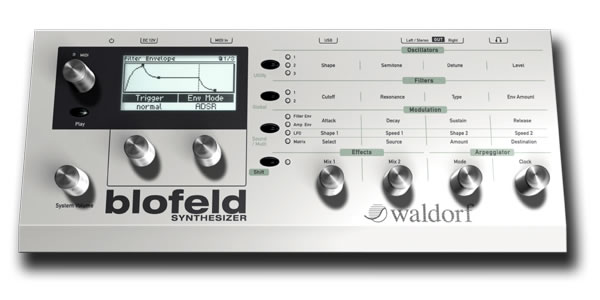L'attesa è stata lunga ma ne è valsa la pena, finalmente è disponibile in Italia l'ultimo gioiello della storica casa tedesca: Waldorf Blofeld.
Il marchio Waldorf rappresenta da molti anni un importante punto di riferimento nel settore dei synth hardware e software. La tecnologia sviluppata dalla casa tedesca, in particolare per i synth della serie Q e per i potenti filtri 'virtual analog', ha un altissimo livello di innovazione ed è alla base di molti virtual instrument della Steinberg.
Con Blofeld la Waldorf ci mette a disposizione un modulo con tecnologia Virtual Analog (compatibile con serie Q) e WaveTable (basato sulla tecnologia PPG), multitimbrico a 16 parti con 25 voci, 3 oscillatori per voce, arpeggiatore e connessione USB.
La resa sonora è quella che ci si può aspettare da un synth Waldorf, con una palette di suoni ricchi e potenti, tutte sonorità ben note a tutti i possessori di prodotti Waldorf come Pulse, Q, Q+, Micro Q, Microwave, Microwave II/XT e lo storico Wave.

fonte: midiware.com
Most important features
- Unbeatable price tag
- sturdy Metal Enclosure
- 7 endless stainless steel Dials
- Graphic Display 128 x 64 pixels, b/w, white background LED
- more than 1000 Sounds
- 3 Oscillators per voice
- Frequency Modulation between the Oscillators
- All Q Oscillator Models
- All Microwave II/XT/XTk Wavetables
- 2 independent Multi Mode Filters per voice
- Filter FM
- 2 Drive stages per voice with selectable Drive Curves
- 3 fast LFOs per voice
- 4 fast Envelopes per voice
- powerful Arpeggiator
- freely programmable Arpeggiator Pattern with up to 16 Steps per Sound
General Features
- up to 25 Voices
- 16 part multi timbral
- more than 1000 Sounds
- sturdy Metal Enclosure
- 7 endless stainless steel Dials
- 5 Buttons
- Graphic Display 128 x 64 pixels, b/w, white background LED
- MIDI LED
- Volume Control
- Power Switch
- Stereo Output
- Headphone Output
- MIDI In
- USB Connector for MIDI In / Out
- uses standard USB MIDI Driver provided by host computer OS
- Windows ME minimum, Windows XP or newer recommended
- Mac OS X 10.2 minimum, Mac OS X 10.3 or newer recommended
- External Power Supply
Per Voice
- 3 Oscillators
Virtual Analog Models:- Pulse with Pulse Width Modulation and adjustable Brilliance
- Sawtooth with adjustable Brilliance
- Triangle
- Sine
- Q Alt 1 and Alt 2 Wavetable with adjustable Brilliance
- All Wavetables from Microwave II/XT/XTk Series with adjustable Brilliance
- Separate Wavetable selectable for Oscillator 1 and 2
Wavetables: - Frequency Modulation between the Oscillators
- Oscillator Synchronization
- Ring Modulator for Osc 1 / 2
- Noise Generator with Noise Colour
- 2 independent Multi Mode Filters
- Filter FM
- Resonance up to Self-Oscillation
- Low Pass 24 dB / 12 dB
- Band Pass 24 dB / 12 dB
- High Pass 24 dB / 12 dB
- Notch 24 dB / 12 dB
- Comb Filter with positive / negative Feedback
- PPG Low Pass Filter
- 2 Drive stages per voice with adjustable Drive Gain and selectable Curves
- Clip
- Hard
- Medium
- Soft
- Sine Shaper
- etc.
- Modulation Matrix with 16 Slots, freely programmable
- Modulation Speed far into Audio Range
- Modulation Sources include all internal Modulation Sources plus various MIDI messages
- Modulation Destinations for almost all continuous sound parameters
- various pre-routed Modulation Destinations with selectable Sources
- Pitch Modulation
- Oscillator 1 / 2 / 3 Frequency Modulation
- Oscillator 1 / 2 / 3 Pulse Width Modulation
- Filter 1 / 2 Cutoff Modulation
- Filter 1 / 2 Frequency Modulation
- Pan 1 / 2 Modulation
- Amp Modulation
- 4 Modifiers for transforming Modulation Sources with various Algorithms
- 3 fast LFOs
- syncable to MIDI Clock
- Note Retrigger with adjustable Start Phase
- monophonic LFO
- Keytrack
- 4 fast Envelopes with selectable types
- Single Trigger / Retrigger per Envelope
- ADSR
- ADS1DS2R (2 Decay/Sustain stages plus adjustable Attack Level)
- One Shot
- Loop S1S2 (Loop between Sustain 1 and 2)
- Loop All (Loop over all stages)
- Poly, Mono, Dual or Unisono Mode with selectable Voice Count
Per Part
- powerful Arpeggiator
- Hold and One Shot modes
- syncable to MIDI Clock
- Direction Up, Down, Alternate
- Range up to 10 Octaves
- various methods to modify Note Sort Order
- freely programmable Arpeggiator Pattern with up to 16 Steps per Sound.
programmable per Step:- Accent
- Timing
- Length
- Glide on/off
- Pause
- Chord
- Previous note
- Random not from Note List
- first and/or last note from Note List
- 1 Effect slot per part
- 1 Effect slot globally for all parts
Effect types:- Chorus
- Flanger
- Phaser
- Overdrive
- Triple FX (S&H, Ring Modulation, Chorus)
- Delay (only available on global Effect slot)
- Clocked Delay (only available on global Effect slot)
- Reverb (only available on global Effect slot)
fonte: waldorfmusic.de